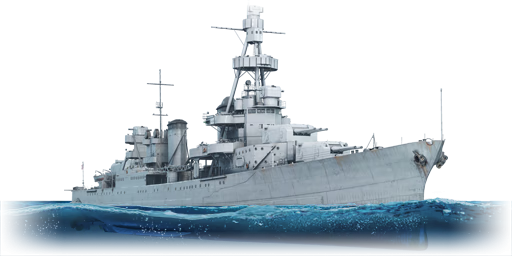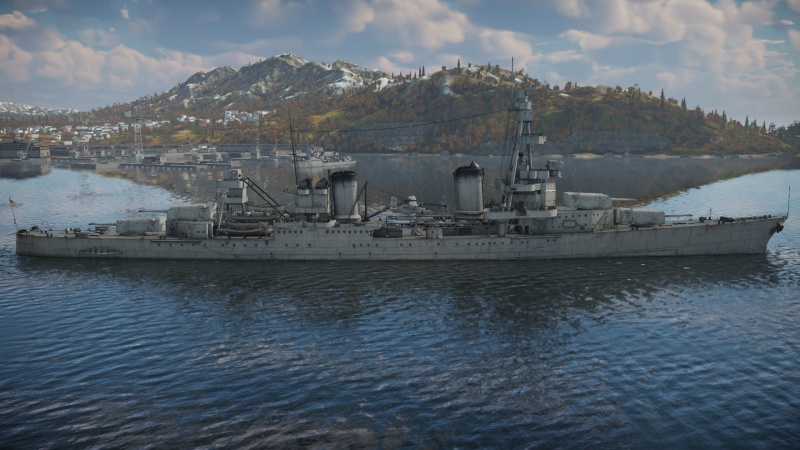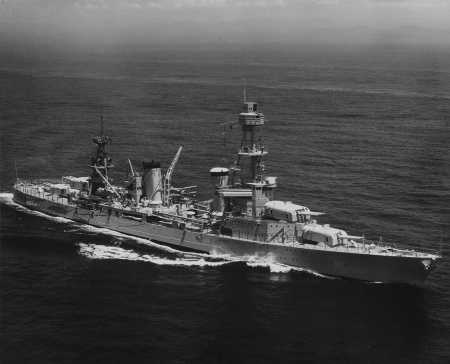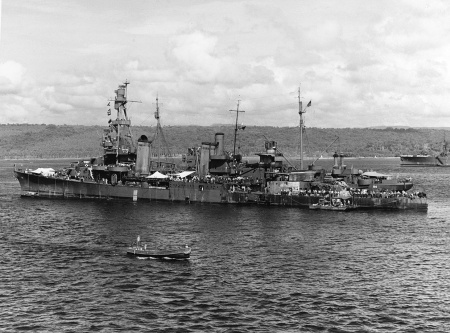USS Pensacola
Contents
Description
Laid down in 1926, the Pensacola-class, USS Pensacola (CA-24), 1941 (also called "Grey Ghost", a nickname given to her by Tokyo Rose) was the lead ship of the Pensacola class of heavy cruisers. She would be completed in February 1930, and notably was one of the first 6 ships to receive radar in 1940. She would see action in the Battle of the Santa Cruz Islands and the Battle of Tassafaronga, and also provided extensive fire support throughout the war in the Pacific, including at Wake and Okinawa. After the war, she would help to transport veterans before being subjected to two atomic blasts as a part of Operation Crossroads. After being studied, she was later sunk as a target ship in 1948.
Introduced in Update 1.93 "Shark Attack", Pensacola is very similar to other American heavy cruisers, with a slightly lighter main battery than the USS New Orleans and a lower battle rating to compensate. Although the HE and SAP shells are lacklustre, the ship does stand out with great penetration for the rank. With relatively weak armour, she does however have adequate secondaries, notably gaining access to proximity fused rounds for her 5-inch guns; with a fast fire rate, these are excellent for shooting down aircraft and destroying lightly armoured ships.
General info
Survivability and armour
USS Pensacola was built under the restrictions of the Washington Naval Treaty, meaning that it had to compromise somewhere to stay under the treaty limit of 10,000 tons displacement, while still meeting the Navy's needs for firepower and speed. In the case of USS Pensacola, the compromise was on armour protection. She has light protection for a heavy cruiser, though of course this still outstrips light cruisers and destroyers.
USS Pensacola's main belt has a thickness of 3 inches. This covers the entire midsection of the ship to protect the machinery spaces, from below waterline up to the armoured deck. The armour forward and aft of this main belt thickens to protect the magazines, 3.5 inches covering the rear magazine and 4 inches protecting the forward magazine. This can be expected to protect from destroyer guns at most ranges and light cruisers at long range, though at close range (inside of 3 km) anything larger than a 5-inch gun will most likely be able to punch through the armour. Speaking of the magazines, these are positioned slightly above the waterline, making them a relatively easy target to hit provided the enemy is at a close enough range to be able to penetrate the ship. Captains are recommended to make course corrections to prevent accurate fire on the magazines.
USS Pensacola, like other American cruisers, has no anti-torpedo bulges. She relies purely on her internal bulkheads to contain the flooding in case of a hit, and hits to the magazine will almost certainly destroy the ship. Captains need to be wary of torpedoes inbound, as USS Pensacola is not equipped to handle these well.
The turrets have 2.5 inches of armour on the face, 1.5 inches on the roof and a paltry 0.75-inch plate on the sides and rear of the turret. This means that captains should avoid exposing anything other than the face of the turret to enemy fire, as even the 40 mm Bofors can easily penetrate and knock the turret out of action from the sides or rear. As for the armoured deck, it is 1 inch thick, and serves only to detonate armour-piercing bombs higher in the ship, as it is incapable of stopping any but the smallest bombs.
In short, USS Pensacola does improve on armour compared to earlier cruisers in the American bluewater fleet such as the Omaha-class, but captains should not rely on her armour to save the vessel as with other later, non-treaty-compliant heavy cruisers. It is recommended to keep the range high and attempt to target lighter cruisers and destroyers, and accurately aiming for weakspots on newer/heavier cruisers.
Mobility
USS Pensacola makes 32.4 kn at flank speed. This is the same speed as the preceding USS Portland, and slightly slower than the later USS Pittsburgh. This speed will allow captains of USS Pensacola to keep pace or slightly surpass the speed of other nation's cruisers, though it will of course be outpaced by light cruisers and destroyers. While Pensacola is capable of making it to take objectives, the floatplanes are recommended to capture objectives, instead of painting a target on the ship. Pensacola's rudder takes approximately 3 seconds to respond at flank speed, and the speed falls to 23 kn while in a sustained turn. Portland takes approximately 40 seconds to accelerate to flank speed, and 1 minute to come to a halt. Captains should be aware that USS Pensacola has a wide turning circle, similar to the preceding Portland, and should give any obstructions a wide berth, as she will be unable to quickly respond to avoid collisions.
| Mobility Characteristics | |||
|---|---|---|---|
| Game Mode | Upgrade Status | Maximum Speed (km/h) | |
| Forward | Reverse | ||
| AB | |||
| Upgraded | 70 | 21 | |
| RB/SB | |||
| Upgraded | 60 | 18 | |
Modifications and economy
Armament
Primary armament
The Pensacola carries a main armament of ten 8"/55 Mk.9 guns in two triple and two twin mounts. These guns are the standard armament for American heavy cruisers, and pack an impressive punch. The guns have good ballistics, and can access four shell types: Mk.14 Common, Mk.19 APCBC, Mk.25 HC and Mk.17 SP Common. Of these shells, the Mk.17 Special Common shell is most effective against cruisers, as it has a great explosive mass and enough penetration for most cruiser main armour belts. The Mk.19 APCBC shell can be used against heavily-armoured targets, but has a relatively small explosive mass of 1.65 kg. Finally, the HC shell, with almost 10 kg of explosive filler, is highly effective against destroyers and unarmoured vessels.
However, the guns have two main drawbacks. Firstly, they have the slowest reload speed of any 8-inch gun, with a fire rate of just three rounds per minute (20-second gun reload). This means that they fire much slower than their contemporaries, which typically have a fire rate of five rounds per minute (12-second reload). As well, the guns have the slowest horizontal turret rotation speed of any heavy cruiser, at just 3.1 degrees/second (comparatively, the Admiral Hipper's guns rotate at 6.8 degrees/second).
| Penetration statistics | |||||||
|---|---|---|---|---|---|---|---|
| Ammunition | Type of warhead |
Penetration @ 0° Angle of Attack (mm) | |||||
| 1,000 m | 2,500 m | 5,000 m | 7,500 m | 10,000 m | 15,000 m | ||
| Mk.14 Common | Common | 116 | 102 | 83 | 69 | 57 | 43 |
| Mk.19 APCBC | APCBC | 383 | 339 | 277 | 228 | 190 | 143 |
| Mk.25 HC | HE | 61 | 61 | 61 | 61 | 61 | 61 |
| Mk.17 SP Common | SP Common | 137 | 121 | 99 | 81 | 68 | 51 |
| Shell details | ||||||||||||
|---|---|---|---|---|---|---|---|---|---|---|---|---|
| Ammunition | Type of warhead |
Velocity (m/s) |
Projectile mass (kg) |
Fuse delay (s) |
Fuse sensitivity (mm) |
Explosive mass (TNT equivalent) (kg) |
Ricochet | |||||
| 0% | 50% | 100% | ||||||||||
| Mk.14 Common | Common | 853 | 117.9 | 0.035 | 9 | 4.84 | 47° | 60° | 65° | |||
| Mk.19 APCBC | APCBC | 853 | 117.9 | 0.035 | 9 | 1.62 | 48° | 63° | 71° | |||
| Mk.25 HC | HE | 853 | 117.9 | 0 | 0.1 | 9.49 | 79° | 80° | 81° | |||
| Mk.17 SP Common | SP Common | 853 | 117.9 | 0.035 | 9 | 4.61 | 48° | 63° | 71° | |||
Secondary armament
The Pensacola carries a secondary armament of eight 5"/25 Mk.13 anti-aircraft guns, mounted on single open-mounts. These cannons are very effective medium-to-long range anti-aircraft guns, but are not effective against any armoured targets. They have access to just two shell types - Mk.36 AAC (HE-TF) and Mk.28 AAC (HE-VT). The former is a time-fuse shell (meaning that the fuse is set before the weapon is fired), while the latter is a proximity fuse shell that explodes automatically upon reaching the target. Both shells are ineffective against armoured targets, having ~35 mm of penetration. However, they are both capable of dealing with air and unarmoured targets quite effectively. The HE-VT shell is typically the better pick, as it offers greatly-improved efficiency against air targets.
The guns themselves are relatively good at short-range defence, being capable of firing at 20 rounds per minute (3-second reload). As well, they have very good vertical and horizontal firing angles. However, take note that the guns fire at a low muzzle velocity of 657 m/s which should be accounted for when manually aiming.
| Penetration statistics | |||||||
|---|---|---|---|---|---|---|---|
| Ammunition | Type of warhead |
Penetration @ 0° Angle of Attack (mm) | |||||
| 1,000 m | 2,500 m | 5,000 m | 7,500 m | 10,000 m | 15,000 m | ||
| Mk.36 AAC | HE-TF | 35 | 35 | 35 | 35 | 35 | 35 |
| Mk.28 AAC-VT | HE-VT | 36 | 36 | 36 | 36 | 36 | 36 |
| Shell details | ||||||||||||
|---|---|---|---|---|---|---|---|---|---|---|---|---|
| Ammunition | Type of warhead |
Velocity (m/s) |
Projectile mass (kg) |
Fuse delay (m) |
Fuse sensitivity (mm) |
Explosive mass (TNT equivalent) (kg) |
Ricochet | |||||
| 0% | 50% | 100% | ||||||||||
| Mk.36 AAC | HE-TF | 657 | 24.42 | 0 | 0.1 | 3.16 | 79° | 80° | 81° | |||
| Proximity-fused shell details | ||||||||||||
|---|---|---|---|---|---|---|---|---|---|---|---|---|
| Ammunition | Type of warhead |
Velocity (m/s) |
Projectile mass (kg) |
Fuse delay (m) |
Fuse sensitivity (mm) |
Arming distance (m) |
Trigger radius (m) |
Explosive mass (TNT equivalent) (kg) |
Ricochet | |||
| 0% | 50% | 100% | ||||||||||
| Mk.28 AAC-VT | HE-VT | 657 | 23.45 | 0 | 0.1 | 457 | 23 | 3.25 | 79° | 80° | 81° | |
Anti-aircraft armament
The 1.1-inch/75 Mk.1 gun, otherwise known as the "Chicago Piano" (because it was the size of a baby grand piano), was the standard anti-aircraft armament for most United States Navy ships prior to the introduction of the 40 mm Bofors cannon - Pensacola carries two of these quad-gun mounts, on the port and starboard side of the bridge respectively. These guns are mediocre at best; they have a good fire rate, similar even to some heavy machine guns, but the shells lack punch in comparison to larger 37 or 40 mm medium anti-aircraft shells common at this rank. Captains should also be advised that the guns only have a HEF-T belt, which leaves them ineffective against coastal vessels with armour.
Pensacola also carries four AN-M2 anti-aircraft guns. The AN-M2 is a navalised anti-aircraft version of the popular Browning machine gun. This gun is rather ineffective at dealing significant damage to enemy aircraft, and is only effective within ~1.5-2 kilometres at most. As well, keep in mind that these guns have a long 12-second reload after the gun's magazine has been used.
Scout plane
Located amidships are two catapults with one SOC-1 scout plane each which provide unique offensive and defensive abilities, expanding tactical options. Ship-launched scout planes fly just like regular tree units but lack munition choices and cockpit views. Alongside the typical abilities of strafing, dropping 2 x 100 lb bombs, and capping zones, the SOC-1 and other scout planes have the added ability to lay down smoke cover (up to 3 times). Captains will be wise to remember to utilise the aircraft and consider when best to use it, for example to cap a point early or late in the match, to create a smoke screen to stymie enemy bombardment and repair, to attack enemy units directly, or perhaps something completely new! With two scout planes one can risk a cap attempt at the beginning of the match, saving the second for any opportunity that presents itself.
Usage in battles
The Pensacola has one of the best broadsides for its battle rating, with ten 8-inch guns, and this should be used to your advantage. Use the accuracy of the guns and the good shell velocity to keep your distance and punish opposing ships from afar. These guns also have a wide array of shell types, allowing you to shoot at any type of craft you fancy with good effect. The guns do have a slow rate of fire, even as far as heavy cruiser guns go, so be sure to keep a good crew and make your shots count. Ranging shots will do you a world of good.
Unfortunately, the strengths of the Pensacola end there, and to do well in this ship, you have to be aware of her many limitations. Firstly, the Pensacola is far from the fastest cruiser. While she's fairly nimble once fully upgraded, she'll still lag behind the fastest cruisers, and will struggle to reposition flexibly. Be sure to plan your movements ahead of time and be aware of the battle around you. Also, the Pensacola is a big, fairly easy target. Other than the armour protecting her front ammo racks, her protection is seriously lacking. Other cruiser guns and torpedoes especially will doom you, and aircraft with big enough bombs can also cause immense damage. Speaking of aircraft, the Pensacola's AA armament is rather inadequate. While the 5-inch guns are fairly effective at long range, her smaller guns are few and far between, and lack the close range damage of 20 mm and 40 mm cannons. Keep an eye out for aircraft, and keep friendly escort ships close by. Lastly, while the guns on the Pensacola are powerful, they still have their limitations. The turret traverse is poor, meaning an enemy on your flank can be a death sentence. In addition, the Pensacola's guns have a 20 second reload, meaning a well-trained crew is a must, especially if you're stuck in a close quarters encounter against any light cruisers that can easily punch through your armour.
To sink a Pensacola
Pensacolas are easy targets for other cruisers. Their armour is weak, they aren't that fast, and their secondary armament is fairly lacking. Don't attack them head-on, where they can angle their bow armour and bring five of their guns to bear. Instead, get on their flank and punish their weak belt armour. The ammo racks for the rear two gun turrets are particularly vulnerable, with just 88.9 mm of armour protecting them from the side, enough for some light cruisers to punch through at medium range.
Pros and cons
Pros:
- Good broadside of ten 203 mm guns - the largest 8-inch gun broadside of any heavy cruiser in the game
- Decent shell velocity and punching power, especially for an 8-inch gun
- Adequate secondary/AA battery of 5 inch guns, which can give destroyers and large aircraft some trouble
- Guns get access to proximity-fused shells (AA-VT) which is extremely effective against aircraft
- Two scout seaplanes
Cons:
- Main guns have an extremely poor fire rate (3 rounds per minute) and poor accuracy at longer ranges
- Weak anti-aircraft defences, with just several 12.7 mm and 28 mm guns, leading to a weak anti-aircraft ability at longer ranges
- Weak survivability with just 3 inches of main armour belt and 4 inches around the armour magazines
- Only 654 crew members, which is a very small crew complement for a heavy cruiser
- No access to torpedoes or any sort of auxiliary armament
History
USS Pensacola was the lead ship of the Pensacola class of heavy cruisers, built for the US navy in the interwar period. Built up to the limitations of the Washington naval treaty, she was the first class of "treaty cruiser" and also the first American cruiser to feature an 8-inch main armament. Pensacola saw extensive service during the Second World War, and was almost sunk by Japanese torpedoes during the Battle of Tassafaronga. After the war, she was used as a target during Operation Crossroads, and was later sunk as a target ship.
Design and Development
After the end of the First World War, the only major cruiser class of the United States Navy were the Omaha class - these ships ended up a disappointment due to their awkwardly-placed main battery and light armour. As a result, the United States Navy set out to produce the first new class of "light cruisers" - the Pensacola class. Due to the Washington Naval Treaty (signed in 1920), the ships could only be built up to 10,000 tons standard. The first of these ships, Pensacola, was laid down in October of 1926 and completed by April of 1930. She was subsequently redesignated as a heavy cruiser (due to her high-calibre main armament) and became the first heavy cruiser class of the United States Navy.
Pensacola displaced 9100 tons standard and was 178 metres long. Her main armament consisted of 10 8-inch (203 mm) guns in a unique configuration - two twin turrets and two triple turrets, one of each being located fore and aft. She carried a secondary armament of eight single 5-inch (127 mm) guns on beam positions. Her initial anti-aircraft armament was sparse, but was improved over time. Pensacola was the first American cruiser to lack torpedo tubes - the American design of "gun cruiser" would be continued with all following cruiser classes except the Atlanta class.
Operational history
Following her commissioning, the Pensacola joined the US Atlantic Fleet where she operated for the next four years. In 1935, she transited the Panama canal to join the Pacific Fleet at San Diego, where she would be based for the rest of her interwar career. She frequently participated in fleet exercises that took her everywhere from Alaska to Midway atoll. She was also one of six ships to receive the CXAM radar system in 1940, the first operational ship-based radar of the United States Navy.
Pensacola departed Pearl Harbour shortly before the raid and headed to the port of Brisbane in Australia after the attack. She then rendezvoused with Task Force (TF) 11, centered around the carrier Lexington. In April of 1942, she returned to Pearl Harbour and was reassigned to the Enterprise escort group. She was still serving in this capacity during the Battle of Midway, where planes from the Enterprise and Yorktown crippled the Japanese carriers Kaga, Akagi, Soryu and Hiryu, the core of the Imperial Japanese Navy. During the course of the battle, she was detached to the Yorktown's escort group, and provided anti-aircraft cover when the carrier was struck by Japanese torpedoes. She managed to shoot down six enemy torpedo bombers, but in vain, as the Yorktown was hit by two more torpedoes and had to be abandoned.
After the Midway battle, Pensacola returned to Pearl Harbour, and was reassigned to the carrier Hornet's escort squadron. She was still serving in this capacity during the Battle of the Coral Sea, and was providing AA fire when the Hornet was hit by multiple enemy bombs and sunk. She was reassigned to USS Enterprise, and provided cover as the carrier launched aircraft during the Battle of Guadalcanal.
Battle of Tassafaronga
After the battle of Guadalcanal, Pensacola was reassigned to TF 67 (with four other heavy cruisers and several destroyers) to attack Japanese forces in the Guadalcanal area. On the night of the 30th of November, they encountered a Japanese transport squadron and promptly engaged them: this battle would be known as the Battle of Tassafaronga. During the battle, Pensacola, along with the other ships, spotted a Japanese troop convoy heading for the Solomons, escorted by eight destroyers. And thus began a short engagement limited by poor night-time visibility where the Japanese destroyer Takamani was sunk by gunfire. However, the rest of the Japanese destroyers were not fired upon, and launched a large number of Type 93 'Long Lance' heavy oxygen torpedoes.
At 23:27, the cruiser USS Minneapolis was hit by two torpedoes in her engine rooms causing her to take heavy damage. New Orleans, the second cruiser in line, took evasive action but was hit by a Type 93 that detonated her forward ammunition magazines and destroyed her bow. As Pensacola turned to avoid the two heavily-damaged cruisers, she was hit by a torpedo underneath her mainmast that caused severe damage - her engine room flooded and her oil tanks were set on fire. The fires then spread aft and eventually caused her rear ammunition magazines to detonate, causing further damage. Pensacola limped back to port, still on fire, with 125 men dead and 68 more injured.
Later service
Pensacola was given emergency repairs by the repair ship Vestal before proceeding back to Pearl Harbour for permanent repairs. She was fully operational again by November of 1943, and spent the last two years of war serving in various capacities. She participated in the battle of Leyte Gulf, and later served in the invasion of Okinawa as a fire support ship. At the end of the war, Pensacola was anchored at Adak Station in Alaska.
Following the cessation of hostilities, Pensacola returned to the Eastern theatre, arriving at Ominato Harbour in Northern Honshu. She then embarked on a long journey back home, repatriating two hundred American veterans to Pearl Harbour, and eight hundred more back to the harbour of San Diego. From there, she embarked on her final trip to Bikini Atoll in the southern Pacific, where she was to be expended as a target ship during the American nuclear bomb tests. She survived both drops, and was studied by the USN to determine the effects of the radiation. She was then finally sunk as a target ship in 1948. Throughout the course of the war, Pensacola received 13 battle stars for her service.
Media
- Skins
See also
Links to articles on the War Thunder Wiki that you think will be useful for the reader, for example:
- reference to the series of the ship;
- links to approximate analogues of other nations and research trees.
External links
References
- Chen, P. C. (2004). Heavy Cruiser Pensacola. Retrieved January 12, 2021, from https://ww2db.com/ship_spec.php?ship_id=303
- Rickard, J. (2014, January 31). USS Pensacola (CA-24). Retrieved January 12, 2021, from http://www.historyofwar.org/articles/weapons_USS_Pensacola_CA24.html
- Schulman, M. (1996). USS Pensacola CA-24Hi. Retrieved January 12, 2021, from https://www.historycentral.com/navy/cruiser/Pensacola.html
| Brooklyn Navy Yard | |
|---|---|
| Cruiser, Light (CL) | |
| Brooklyn-class | USS Brooklyn · USS Helena |
| Heavy Cruisers (CA) | |
| Pensacola-class | USS Pensacola |
| Battleships (BB) | |
| Pennsylvania-class | USS Arizona |
| USA heavy cruisers | |
|---|---|
| Pensacola-class | USS Pensacola |
| Northampton-class | USS Northampton |
| Portland-class | USS Portland |
| New Orleans-class | USS New Orleans |
| Baltimore-class | USS Baltimore · USS Pittsburgh |
| Des Moines-class | USS Des Moines · USS Newport News |







